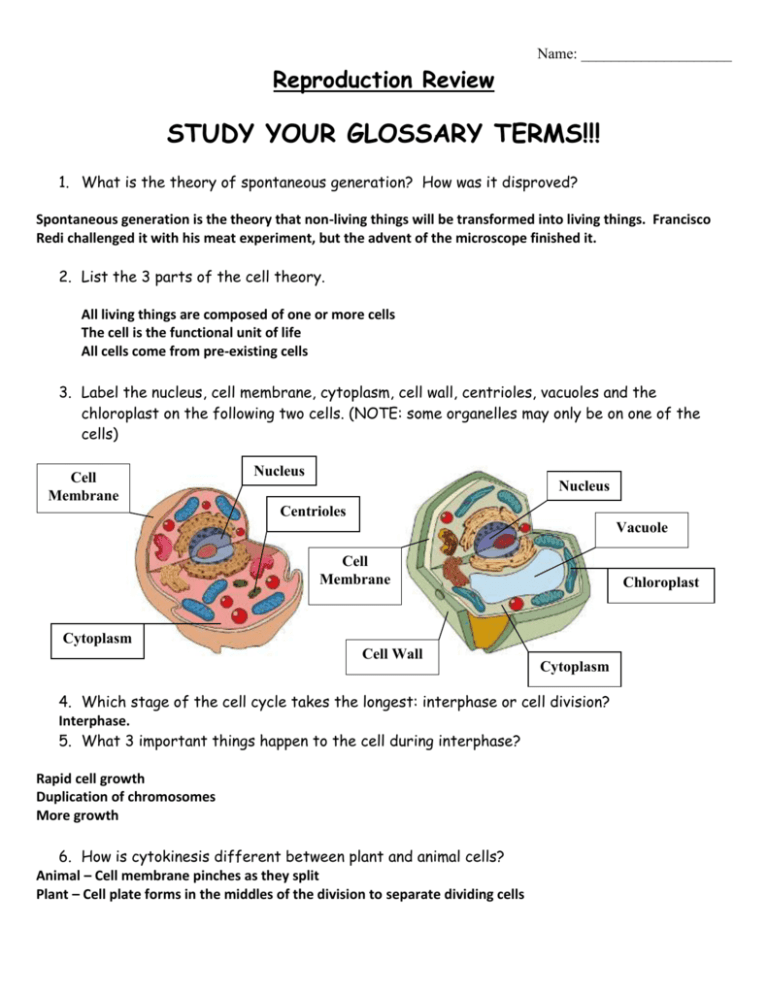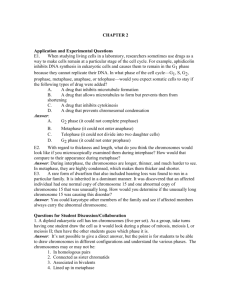Reproduction review (Answer Key)
advertisement

Name: ____________________ Reproduction Review STUDY YOUR GLOSSARY TERMS!!! 1. What is the theory of spontaneous generation? How was it disproved? Spontaneous generation is the theory that non-living things will be transformed into living things. Francisco Redi challenged it with his meat experiment, but the advent of the microscope finished it. 2. List the 3 parts of the cell theory. All living things are composed of one or more cells The cell is the functional unit of life All cells come from pre-existing cells 3. Label the nucleus, cell membrane, cytoplasm, cell wall, centrioles, vacuoles and the chloroplast on the following two cells. (NOTE: some organelles may only be on one of the cells) Cell Membrane Nucleus Nucleus Centrioles Vacuole Cell Membrane Chloroplast Cytoplasm Cell Wall Cytoplasm 4. Which stage of the cell cycle takes the longest: interphase or cell division? Interphase. 5. What 3 important things happen to the cell during interphase? Rapid cell growth Duplication of chromosomes More growth 6. How is cytokinesis different between plant and animal cells? Animal – Cell membrane pinches as they split Plant – Cell plate forms in the middles of the division to separate dividing cells Name: ____________________ 7. Match the following pictures with the correct stage of mitosis: Interphase Prophase Metaphase Anaphase Telophase Telophase Metaphase Anaphase Prophase Interphase 8. Label the chromosomes, spindle fibres and centrioles on the following diagram of a cell during mitosis. Chromosomes Spindle Fibres Centrioles 9. Match the following pictures with the correct stages of meiosis I: Prophase I Metaphase I Anaphase I Telophase I Anaphase I Telophase I Prophase I 10. Match the following pictures with the correct stages of meiosis II: Prophase II Metaphase II Anaphase II Telophase II Prophase II Telophase II Metaphase II Metaphase I 4 haploid cells Anaphase II 4 haploid cells Name: ____________________ 11. Match the following stages of mitosis with their description: a) interphase b) prophase c) metaphase d) anaphase e) telophase __C_ double-stranded chromosomes line up in the middle of the cell __A_ the cell grows and duplicates its chromosomes __E_ the nuclear membrane forms around the chromosomes and cytokinesis occurs. __B_ the duplicated chromosomes shorten and thicken __D_ the two halves of the chromosomes move to opposite poles of the cell 12. Match the following stages of meiosis with their description: a) prophase I c) anaphase I e) prophase II g) anaphase II b) metaphase I d) telophase I f) metaphase II h) telophase II _B__ homologous chromosomes line up at the equator (middle) of the cell. _H__ both daughter cells divide, forming haploid cells. _G__ sister chromatids separate and move to either side of the cell _F__ sister chromatids line up at the equator (middle) of the cell _D__ the cell divides into two daughter cells _A__ chromosomes have duplicated forming homologous pairs. _C__ homologous chromosomes are pulled apart; one chromosomes goes to either side _E__ each cell has one of the homologous chromosomes (chromosomes NOT duplicated here) 13. Match the type of reproduction with its description: a) binary fission d) spore formation b) budding e) parthenogenesis c) fragmentation/regeneration f) vegetative reproduction g) conjugation h) hermaphrodite j) pollination __G_ two paramecium exchange DNA by making contact with each other __B_ a small yeast cell starts growing off of a parent yeast cell. It eventually breaks off __A_ a bacteria duplicates its DNA and then splits into two new bacteria __H_ an organism has both male and female sex organs __J_ pollen reaches the egg in a flower and forms a zygote __F_ a potato is pulled off a plant, put into the ground and grows into a new plant __C_ a sea star’s leg is cut off and it re-grows a new one __E_ a female komodo dragon has a “virgin” birth without having contact with a male __D_ a mushroom cap produces tiny spores to the ground that grow into new mushrooms. Name: ____________________ 14. Check off whether the following statements belong to mitosis or meiosis. Description Produces four cells Daughter cells are clones of mother cell Haploid cells produced Somatic cells undergo this cell division Formation of sex cells Two stages of division Asexual reproduction, growth and repair of cells Begins with DNA duplication Mitosis Meiosis 15. If a dog has 78 chromosomes, how may chromosomes would be in the following cells: a. b. c. d. e. A sperm cell? __39_ An egg cell? __39_ A skin cell? __78_ A zygote? _78__ A brain cell? _78__ 16. Label the parts of the flower on the following diagram: Petal Anther Stigma Filament Style Stamen Ovary Sepal Stem 17. Be able to explain, diagram, and label the flower pollination process. See notes! Pistil Name: ____________________ 18. Be able to label the following diagrams if I give you the words: Vas Deferns Entry Capsule Epididymis Epididymis Energy Source Seminferous Tubules Testis Flagellum Nucleus Uterus Fallopian Tube Egg cell with nutrient cells Follicles Egg Corpus Luteum 19. Match the following a) Eggs b) ovaries e) sperm f) flagellum i) epididymis j) vas deferens m) ovulation n) menstruation q) zygote r) embryo Follicle Ruptures Ovary Vagina c) uterus g) testes k) follicle o) endometrium s) fetus Endometrium Cervix d)oviduct (fallopian tubes) h) seminiferous tubules l) corpus luteum p) vagina _E_ male reproductive cells _L_ nutrient cells that remain in the ovary _A_ female reproductive cells _K_ cells in the ovary that produce an egg _G_ primary male reproductive organ _M_ the process of releasing an egg _B_ primary female reproductive organ _O_ the thick lining of the uterus (where _C_ where the embryo develops and grows the embryo embeds) _D_ where fertilization takes place _P_ the birth canal _N_ the process of shedding the endometrial cells _Q_ the cell that forms when a sperm _F_ the tale of a sperm fertilizes an egg. _J_ the tube where sperm is released from _S_ the organism 9 weeks after fertilization _I_ where sperm complete their development _R_ the dividing fertilized cell about 100 cells _H_ the tiny twisting tubes lined with reproductive cells to make sperm






